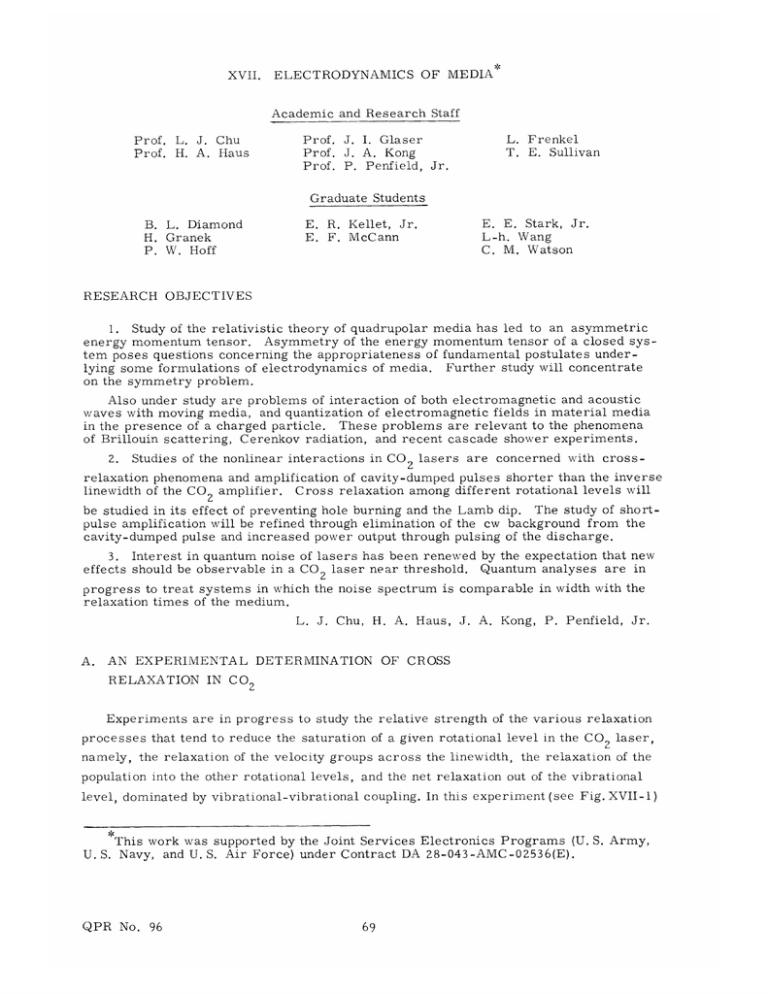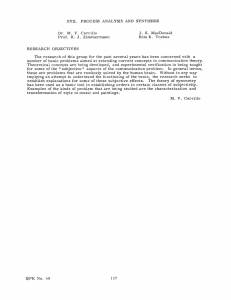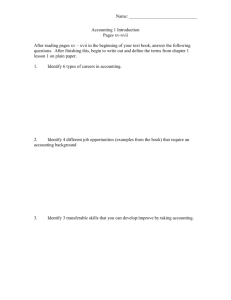XVII. ELECTRODYNAMICS OF MEDIA* J.
advertisement

XVII. ELECTRODYNAMICS OF MEDIA* Academic and Research Staff Prof. J. I. Glaser Prof. J. A. Kong Prof. P. Penfield, Jr. Prof. L. J. Chu Prof. H. A. Haus L. Frenkel T. E. Sullivan Graduate Students E. R. Kellet, Jr. E. F. McCann B. L. Diamond H. Granek P. W. Hoff E. E. Stark, Jr. L-h. Wang C. M. Watson RESEARCH OBJECTIVES 1. Study of the relativistic theory of quadrupolar media has led to an asymmetric energy momentum tensor. Asymmetry of the energy momentum tensor of a closed system poses questions concerning the appropriateness of fundamental postulates underlying some formulations of electrodynamics of media. Further study will concentrate on the symmetry problem. Also under study are problems of interaction of both electromagnetic and acoustic waves with moving media, and quantization of electromagnetic fields in material media in the presence of a charged particle. These problems are relevant to the phenomena of Brillouin scattering, Cerenkov radiation, and recent cascade shower experiments. 2. Studies of the nonlinear interactions in CO2 lasers are concerned with cross- relaxation phenomena and amplification of cavity-dumped pulses shorter than the inverse linewidth of the CO 2 amplifier. Cross relaxation among different rotational levels will be studied in its effect of preventing hole burning and the Lamb dip. The study of shortpulse amplification will be refined through elimination of the cw background from the cavity-dumped pulse and increased power output through pulsing of the discharge. 3. Interest in quantum noise of lasers has been renewed by the expectation that new effects should be observable in a CO 2 laser near threshold. Quantum analyses are in progress to treat systems in which the noise spectrum is comparable in width with the relaxation times of the medium. L. J. Chu, H. A. A. AN EXPERIMENTAL DETERMINATION RELAXATION IN CO Haus, J. A. Kong, P. Penfield, Jr. OF CROSS 2 Experiments are in progress to study the relative strength of the various relaxation processes that tend to reduce the saturation of a given rotational level in the CO 2 laser, namely, the relaxation of the velocity groups across the linewidth, the relaxation of the population into the other rotational levels, and the net relaxation out of the vibrational level, dominated by vibrational-vibrational coupling. In this experiment (see Fig. XVII- 1) *This work was supported by the Joint Services Electronics Programs (U. S. Army, U. S. Navy, and U. S. Air Force) under Contract DA 28-043-AMC-02536(E). QPR No. 96 (XVII. ELECTRODYNAMICS MECHANICAL TURNER OF MEDA) OSCILLATOR TO SYNCHRONOUS AMPLIFIER OSCILLATOR TO X - Y RECORDER SATURATING ABSORBER SPECTROMETER PROBE DETECTOR X INPUT FROM RAMP VOLTAGE Fig. XVII-1. a saturating CO 2 FREOUENCY REFERENCE FROM CHOPPER Schematic of experiment probing the rotational lines of CO . 2 laser tuned to a 10. 6-i R line is chopped (chopper in position 1) at a low frequency and modulates the population of a laser amplifier. A low-intensity beam colinear with the saturating beam is used to probe the effects of the modulation on the gain or absorption of other lasing lines of the amplifier. The probe beam is the output of a piezoelectrically tuned oscillator that can be swept across the linewidth of many P transitions. (The sweep of the piezoelectric oscillator has been calibrated in frequency by beating this laser against a fixed laser on the same line.) The probe beam is separated beyond the amplifier by a grating, and after detection is synchronously narrowband amplified at the chopper frequency. Thus only the effect on the gain of the probe lines through modulation of the amplifier population is observed. A sample output is shown in Fig. XVII-2b for gain (discharged gas) and XVII-2c (cold gas). With the chopper in position 2, the saturating beam blocked, and the discharge on and off we can produce gain curves for the probe line, as shown in Fig. XVII-2a. For a saturating line of R (20) used in the present experiments, all of the P transitions can be affected by the radiation field only through the rotational cross coupling, with the exception of P (22), which shares a common upper level with R (20), and P (20), which shares a common lower level. With the discharge turned on in the amplifier, the radiation field attempts to produce a Lamb dip in the upper lasing level; however, because of velocity cross relaxation, the entire level will tend to be pulled down to some extent and, because of rotational relaxation, other lines can show either the Lamb dip, or the over-all pull-down, or both. Likewise, in this case the lower levels are QPR No. 96 ---- ---------~--- -- ---- I __ IELa~ I ~ (XVII. 2 4x10 ELECTRODYNAMICS OF MEDIA) SCALE COMPARED WITH (Ib) AND (Ic) I MHz I MHz Fig. XVII-2. (a) Gain measurement of probe line P(12), 0. 6 Torr N2, 0. 6 Torr CO . (b) Change in absorption on probe line P(12), saturating line R(20). (c) Gain measurement of probe line P(12), 0. 6 Torr N2, 0. 6 Torr CO 2. correspondingly filled because of the radiation field. Without the discharge, the gas in the amplifier provides absorption, and the saturating laser pumps population into the upper level, thereby reducing absorption on all levels. The process is controlled by these same parameters that depend upon the relaxation times which now, with a discharge, assume different values. In a previous report, the cross relaxation applicable to a multilevel upper QPR No. 96 --- _ _ ___ ___ (XVII. ELECTRODYNAMICS OF MEDIA) vibrational state with an entirely depleted lower vibrational state is treated. A simple extension of this approach to include the lower level includes the cases for both gain and absorption: N (e) 2) An = - N(e) - 2 N(e) J2 N(e) 2 N (e) gf + W(v) 2 f 1 AnJ2 2 f W(v) f(v) dv f(v) N g (1) 2 2 N (e) f(v) g 9 f W(v) f(v) dv ,, + W(v) Y2 T2 Y? A2/z 2 (2) y2 + 1/T2 + A2/z2 2 where T 1 ' (3) S- ( y 22 + 2yz+1 y+ + z T z ' y+ S(,+A) (T 1 T (4) + Z A (5) with similar solutions for the lower level with a change in sign. From initial measure- ments we have determined that the relative pull-downs are J-independent for 0. 6 Torr CO 2 and 0. 6 Torr N 2. At this pressure there was no Lamb dip; hence, we may assume that the second term in brackets in Eqs. 1 and 2 is negligible compared with the first term. If we look at the ratio of change in gain to gain on the lasing line to that on the nonlasing lines, we get y T2 2 2 + 1= 4 T A z QPR No. 96 1 2+-+A ZT + (experimentally). (XVII. ELECTRODYNAMICS OF MEDIA) - > A in order to see this effect where y might be smaller than either from physical arguments, and z can be calculated from equilibrium population to be approximately 14. If we take the equality between I/T and y, we find We must have _ _ =3 T or y 1 A. 2A/z Furthermore, we know that y cannot be too small compared with A because the system would not have been able to reach a new equilibrium in which the changes in the lasing level are appreciably different from changes in the other lines. An appropriate value -1 3 Also, no Lamb of A has been given as ~107 sec- for -1 Torr from the work by Cheo. dip was observed, even at 0. 3 Torr CO 2 and 0. 3 Torr N2, in this amplifier experiment. H. Granek References 1. H. A. Haus and P. W. Hoff, "Cross Relaxation in a Multilevel System," Quarterly Progress Report No. 94, Research Laboratory of Electronics, M. I. T. , July 15, 1969, pp. 80-85. 2. See graphs (Fig. V-i) in H. A. Haus and P. W. Hoff, "Effect of Cross Relaxation on Lamb Dip," Quarterly Progress Report No. 93, Research Laboratory of Electronics, M. I. T. , April 15, 1969, pp. 43-48. 3. P. K. Cheo and R. L. Abrams, "Rotational Relaxation Rate of CO Appl. Phys. Letters 14, 47 (1969). B. Laser Levels," SOLUTION OF WAVEGUIDE SCATTERING PROBLEMS BY FINITE-DIFFERENCE 1. 2 GREEN'S DYADICS Introduction This report deals with a finite-difference Green's dyadic method for the numerical calculation of the induced current distribution and equivalent circuit for time-harmonic TM modes in a two-dimensional parallel-plate waveguide impinging on a class of metallic obstacles. The class of obstacles is that with obstacle sides either parallel or perpendicular to the waveguide axis. In a previous report the finite-difference method was The TM probused to solve TE mode scattering problems in parallel-plate waveguide. lem involves a Green's dyadic rather than a scalar Green's function because induced currents flow in two dimensions rather than in one. The equivalent susceptance of a transverse semidiaphragm that was computed by This work GK-3370). QPR No. 96 was supported in part by the National Science Foundation (Grant (XVII. ELECTRODYNAMICS OF MEDIA) using a 50-element approximation for the induced current distribution is 2. 06% greater than the exact value; this computation takes 1. 98 min on the IBM 360/65 computer, and costs $6. 62. This report gives a formulation of the finite-difference Green's dyadic for TM modes and the finite-difference boundary-value problem. The round-off error, sampling error, and computation costs vs number of current elements and the induced current distribution for the semidiaphragm are presented. 2. Finite-Difference Green's Dyadic As described in a previous report, the time-harmonic Maxwell's equations can be approximated by the method of finite differences, so that each field and current component is evaluated at a different point of a cubic lattice. 2 The finite-difference Green's dyadic for TM modes in a parallel-plate waveguide is defined as the electric field solution to the finite-difference Maxwell's equations, subject to boundary conditions at the parallel plates for a discrete electric current distribution that is nonzero only at one point. The geometry of the parallel-plate waveguide and the lattice points of interest I E AND J O- Ez AND J * H Y POINT z POINT POINT a K Fig. XVII-3. QPR No. 96 Geometry of lattice and parallel-plate waveguide. (XVII. is two-dimensional, and is shown in Fig. ELECTRODYNAMICS XVII-3. OF MEDIA) The coordinates x, y, and z are Cartesian, and the field and current components are independent of y. magnetic field component of interest is The complex H (x, z) and the associated complex electric field components are E x(x, z) and E (x, z); the complex electric current densities are x zjt given by Jx (x, z) and Jz(x, z). will be omitted. The time factor e , where co is the angular frequency, Arrows indicate the direction of the electric field associated with each lattice point, and the numbering scheme is such that each lattice point is labeled by two integers, p and r. Ex(p, r) = Ex(x , Z) x= (p+ 1 / z z=ra Ez(p, r) = Ez(x z)I , 2 )a =pa z= (p+1/2)a H y(p, r) = H (x, z) x=(p+1/2)a (1) z=(p+l/2)a The electric current density components are numbered exactly as the electric field components. The finite-difference form of Maxwell's equations is given by E (p, r) - E (p+l , r) + Ex (p, r+l) - Ex (p, r) = -j (2) aH y(p, r) (3) -H (p, r) + H (p, r-1) = joE aE (p,r) + aJ (p, r) -H where (p-1, r) + H y(p, r) = jw (4) aE (p,r) + aJ (p, r), a is the length of the side of one cell, Eo is the permittivity of free space, [o is the permeability of free space. Table XVII-1. The boundary conditions at the parallel plates are Comparison of finite-difference TM modes and exact TM modes. Exact TM Mode Finite-Difference TM Mode Hy cos Ex (e s p+ -/M S-1)/jwEo e cos cos (mwTx/L) e-NZ s sw p+ /M) e (y/j.o) cos (mwrx/L) e-YZ -wr Ez -(2 sin(sT/2M)/jE 0o) sin (slTp/M) e w = j2 sin-1 ((ka/2)2 s = 0, 1,2,...M-1 QPR No. 96 and s sin 2 (sT/2M)) -((mT/L)/jo = j k 2 ) sin(mx/L) e - y - (m/L) m = 0, 1,2,... 2 z ELECTRODYNAMICS OF MEDIA) (XVII. obtained by choosing the origin of the lattice so that the Ez points fall along the plate boundaries. E Z (p,' r) = 0 for p = 0 and p = M. (5) The finite-difference TM modes are solutions to Eqs. 2-5 with J = 0 and J = 0. These x z modes are compared with the exact TM modes in Table XVII-1. Here, k is the propagation constant of free space and L = Ma. The properties of these modes have been 3 discussed elsewhere. Green's dyadic has 4 terms, Gxx Gxz, Gzx G Ex(p, r) - Gxx(P , r, px, rx) Jx E z (p, ' r) Gzx(p, r,Px x x rx)x + x'z+ defined by Gxz(p, r, Pz, rz) Jz (6) Gzz(p, r,Pz9 z r (7) Z )Jz z where (Px, rx) denotes the location of an x-directed current density element of value jx' and (Pz, rz) denotes the location of a z-directed current density element of value j . The dyadic is obtained by solving Eqs. 2-5, with J x and J z given by Jx = x6 6 ppx rrx (8) = j 6 6 zPP rrz z z (9) J z where 6 denotes a Kronecker delta function. The solutions are obtained by using the following completeness relations for the modes s=M-1 = (2/M) 6 E cos sp+ /M cos (sTr(px+ 1 (10) /M s=0 s=M-1 6 PP sin (sTrp/M) sin (sTrpz/M), =(2/M) (11) s=O where E s = 1 for s = 0 and 1 for s # 0. 2 6 G xx = (-1/jwE )6 o pp rr + x ( s=M-1 ' wE0/ MI (2us(r-rx)-us(r-rx-1)-u s(r-rx+1)) QPR No. 96 cos s s )) cos (S Tr ( M )) 2 sinh w s=O (12) ELECTRODYNAMICS OF MEDIA) (XVII. s= = G xzG = (. jwE1 -, 1 2/ sin(ST') (s (P+ o Cos L s=l (2M )) sin (sipz M M sinh w kUs 1-1 z )-U s I-I Z_ -1/1 s (13) s=M-l G G zx = . 1 sin 2 0 (O jeo sin 2M ) s=l (s( Cos nM sinh w 1 (u s (r-r s x)-u s(r-rx x +1)) x s (14) s=MG = (-i/jwco)6pp 6 2 sin 2 + (2~ o)() sin sinh w s=1 sin z u s(r-rz ), sz s (15) where us is given by Us(r) = exp(-ws r ). Green's dyadic has been Fig. XVII-4. (16) calculated Here, G xx/Z for the x-directed current element shown in and G x/Z , where Zo is the characteristic impedance of free space, are given for 10 different points. The frequency and dimensions have been chosen so that 2 modes are above cutoff. 3. Finite-Difference Boundary-Value Problem Solution The finite-difference solution to the problem of determining the current distribution induced on a metallic obstacle in a parallel-plate waveguide by a TM field is obtained in three steps. 1. The current distribution on the surface of the obstacle is approximated by a set of x- and z-directed current elements having unknown amplitudes. 2. The Green's dyadic is used to compute the electric field produced at each current element location, under the assumption that each current element is excited one at a time. 3. The boundary condition that the total electric field, incident plus scattered, van- ishes at each current-element location yields a set of simultaneous linear equations for the current amplitudes. The x-directed current-element locations will be labeled by the coordinates (Pi, ri)' the current amplitudes by ji, and the value of the incident x-directed electric field at that element by E(i), where i is an index running from 1 to Nx9 the number of x-directed QPR No. 96 (XVII. ELECTRODYNAMICS OF MEDIA) p(x) M = 100 54 L =0.9 INCH 3 X/L= 1.1 2 1 EXCITED ELEMENT 6678910 CENTER OF WAVEGUIDE 05 5 0 1 10 r (z) 2.0x 1.0x 1 2 4 3 5 -1.0x 10 4.0x 10 3 2 4.0x .0x 10 3.0x - .0x 10 2.0x - 1.0x 10 1.0x 6 7 9 8 1 10 6 ELEMENT NUMBER Fig. XVII-4. current elements. 8 9 10 Green' s dyadic for x-directed current element. The same labels will be used for the corresponding z-directed vari- ables with i running from N rent elements. 7 ELEMENT NUMBER + 1 to N + N , where N is the number of z-directed cur- The scattered field produced at each current element location, e(i), is then related to the current amplitudes by e(i) = N +N x z Y gikjk' k=l (17) where Gxx(Pi, ri' Pk' rk) 1< i, k < N G xz(Pi'., ri' Pk rk) 1<i< Nx; N + 1 Sx k< N +N z (18) Gzxz (Pi, ri' k'rk) Gzz(Pi' ri' Pk' rk) QPR No. 96 N + 1 X< i, k, <N X + N Z (XVII. ELECTRODYNAMICS OF MEDIA) The boundary condition at the current elements is given by E(i) + e(i) = 0 1 i< N x +N and yields the following set of N x + N (19) simultaneous equations: N +N x z gikk + e(i) = 0. I (20) k=l Solution to Eq. 20 for jk can be accomplished by Gaussian elimination. The x-directed electric field of the scattered TEM (s = 0) mode can then be computed from the following I-r expressions. -w r Ae r > r. 1 (21) (TEM) E x x = +w r r < r. e 1 where N tanh (wo/2) A A = -1 __ oi1 jwE M =( i-) ( -) A N x -rkw jk e tanh (w /2) j Eo) (I- -I 4. x rkw° Z jk e k=l ° (22) k=1 Practical Limitations of the Method The practical limitations on the use of the method described here are sampling or discretization errors inherent in the finite-difference approximation, computation roundoff error, and computation cost or time. The scattering of a TEM mode from a trans- verse semidiaphragm (capacitive iris) was solved in order to evaluate these limitations. The induced current distribution was obtained from Eq. 20 with N Gaussian elimination, and is shown in Fig. XVII-5. was +377 V/m at r = 0, x = 50 and N z = 0 by The incident electric field strength M = 100, and X/L = 2. 1, where k is the free-space wavelength. The accuracy of the computation was tested by recomputing the scattered field at each current element location; these residual-field errors are also plotted in Fig. XVII-5 The equivalent susceptance of the transverse semidiaphragm was computed and compared 4 with a value computed to 6-place accuracy by means of an exact series given by Collin. These values are plotted against wavelength in Fig. XVII-6a. The discretization error, which is defined as the percentage difference between the computed and exact QPR No. 96 2 .0x10 4 TRANSVERSE SEMIDIAPHRAGM REALPARTOF J IMAG. PARTOF J 1.0x104 0 LYZ 0.03 S0.02 r, 0.01 0.10 Fig. XVII-5. 0.20 0.30 POSITION x/L 0.40 0.50 Induced current distribution and residual field error of transverse semidiaphragm. N cao m uu z 3.0 FINITE-DIFFERENCE VALUE FOR 50 CURRENT ELEMENTS LU 2.0 z EXACT VALUE - > 1.0 a I I I 2.0 2.2 2.4 I I 2.6 2.8 I 3.0 X/L (a) 0.03 z 0 0.02 c u. O 0.01 o Z 0 10 20 30 40 Nx NUMBER OF CURRENT ELEMENTS Fig. XVII-6. QPR No. 96 (a) Computed and exact equivalent susceptance of transverse semidiaphragm vs wavelength. (b) Discretization error, round-off error and computation costs vs number of current elements. (XVII. susceptance, ELECTRODYNAMICS OF MEDIA) is plotted in Fig. XVII-6b against number of current elements. The com- putation costs and the round-off error, which is defined as the maximum residual-field error, are also plotted against number of current elements in Fig. XVII-6b. The cost of computation on the IBM 360/65 computer was $3. 34 per 450K byte-min for centralprocessing unit time. J. I. Glaser References 1. J. I. Glaser, "Solution of Waveguide Obstacle Problems by a Finite-Difference Method," Quarterly Progress Report No. 93, Research Laboratory of Electronics, M. I. T. , April 15, 1969, pp. 49-65. 2. J. I. Glaser, "Maxwell's Equations for Discrete Space," Quarterly Progress Report No. 92, Research Laboratory of Electronics, M. I. T., January 15, 1969, pp. 211219. 3. Ibid. , pp. 218-219. 4. R. E. Collin, Field Theory of Guided Waves (McGraw-Hill Book Company, New York and London, 1960), p. 452, Prob. 10. 6. QPR No. 96






